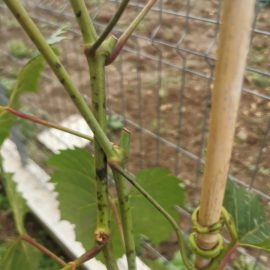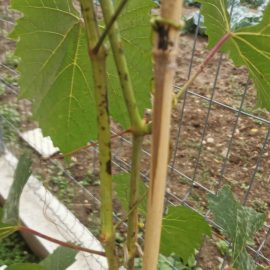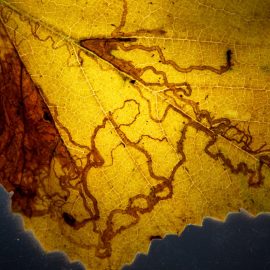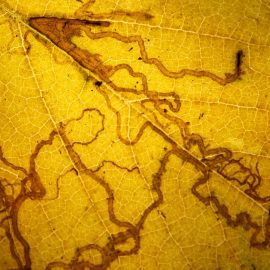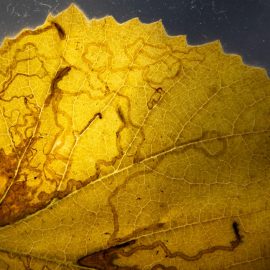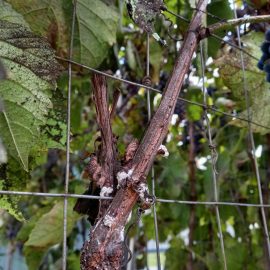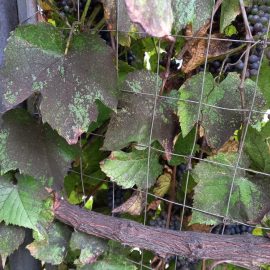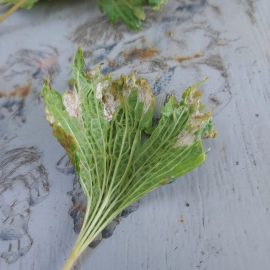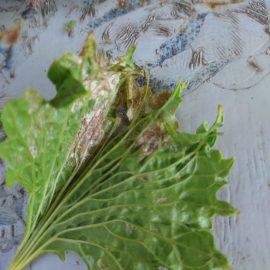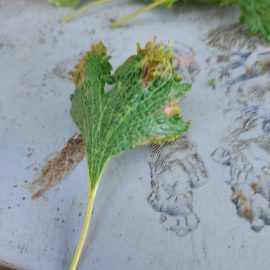Grapevine treatments, pest and disease control
Published on: January 10, 2022 Modified on: 24 April 2024
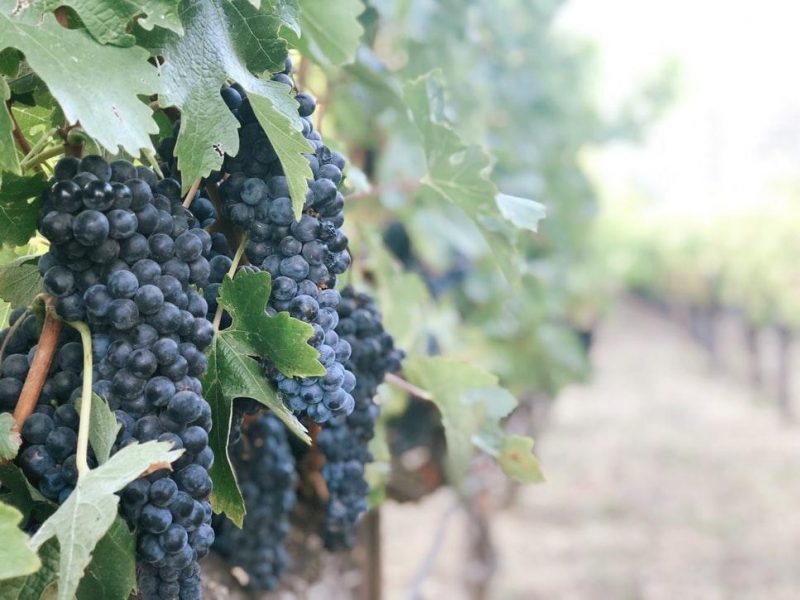
The grapevine (Vitis vinifera) is a creeper plant, part of the Vitaceae family. This plant has been introduced as a common crop thousands of years ago. Since ancient times, grapes have been used to produce wine. The grapevine is a creeper, its leaves are big and palmate, arranged alternately. The flowers are arranged in compound raceme-like inflorescences, and the fruits are berry-like, of various shapes and colors grouped in clusters. The grapes are the most cultivated fruits in the world as they are used for making wine. They contain Thiamine, Riboflavin, Niacin, Vitamin B6, Folic Acid, Vitamin B12, Vitamin C, Vitamin K, Calcium, Iron, Magnesium, Manganese, Phosphorus, Potassium, Sodium, Zinc. The largest grape-producing countries are China, Italy, the USA, Spain, and France.
MAIN DISEASES OF GRAPEVINE
Viruses
Grapevine fanleaf virus
The attacked plants have under-developed shoots, with short inter-knots, placed in a zig-zag form. The plant also has a bushy aspect due to the chaotic shoot growth. The leaves are under-developed, deformed, and have a fan aspect. Sometimes, on the affected organs, greasy spots appear, which give the plant a mosaic appearance. If the attack is severe, the grapes remain small and don’t reach maturity. The virus is transmitted by grafting, through root contact and nematodes.
Prevention and control measures:
- the use of healthy planting material;
- control of soil nematodes.
Grapevine vein mosaic virus
The characteristic symptoms of this disease are the yellowing of the leaf veins. Therefore, the leaf will have a mosaic aspect. The plant’s growth is not affected. This disease is spread only by grafting and layering.
Prevention and control measures:
- the use of healthy planting material.
Grapevein leaf roll virus
Plants attacked by this virus show severe growth stagnation. The red grape varieties have reddish leaves and the white grape species have yellowed leaves. The disease progresses and the leaves twist along the veins. Towards autumn, the attacked leaves intensify their specific color (red or yellow). Following the attack, production decreases in quantity and quality, and plants are susceptible to frost. The virus is transmitted by aphids and through infected plant material.
Prevention and control measures
- the use of healthy planting material;
- remove the affected plants from the crop.
Mycoplasmosis
Grapevine flavescence doree
The symptoms can be seen on a few plant shoots. The leaves of the affected shoots turn yellow, either partially or totally, and have a specific metallic color. The attack is followed by a twist and fall off of the leaves. Following the attack, the shoots are sensitive to frost, the grapes do not develop uniformly, and contain a small amount of sugar. This disease is transmitted by a leafhopper (Scaphoideus titanus).
Prevention and control measures:
- burning of attacked plants;
- application of insecticides to keep leafhopper population under control.
Bacteriosis
Crown gall disease (Agrobacterium radiobacter pv. tumefaciens)
In the case of grapevines, the disease is manifested on the stump and cordons, very rarely on the roots. Big and specific tumors grow on the stump, small and coral-shaped little tumors grow on the cordons.
Prevention and control measures:
- use of healthy planting material;
- avoiding causing any injuries when performing maintenance works;
- cutting the affected organs and applying a healing mastic;
- applying a treatment in early spring with Bordeaux mixture 2-3% or copper-based products.
Recommended products
-
You can find products on a different store
Change Store -
You can find products on a different store
Change Store -
You can find products on a different store
Change Store -
You can find products on a different store
Change Store -
You can find products on a different store
Change Store -
You can find products on a different store
Change Store -
You can find products on a different store
Change Store -
You can find products on a different store
Change Store -
You can find products on a different store
Change Store -
You can find products on a different store
Change Store -
You can find products on a different store
Change Store -
You can find products on a different store
Change Store -
You can find products on a different store
Change Store -
You can find products on a different store
Change Store -
You can find products on a different store
Change Store -
You can find products on a different store
Change Store -
You can find products on a different store
Change Store -
You can find products on a different store
Change Store -
You can find products on a different store
Change Store -
You can find products on a different store
Change Store -
You can find products on a different store
Change Store -
You can find products on a different store
Change Store -
You can find products on a different store
Change Store -
You can find products on a different store
Change Store
Mycosis
Grapevine downy mildew (Plasmopara viticola)
This disease affects all the plant’s organs. In spring, oily spots appear on the leaves, with a diffuse outline and varied sizes. As time passes, the spots turn brown and the leaves look burned. On the inferior side of the leaves, next to the spots, a white fluff appears. During autumn, the plants are more resilient to the attack of this disease. Therefore, small and pointy spots can be seen on the leaves, next to which, the tissues turn brown. During this period, the white fluff no longer appears on the inferior side of the leaves. On the shoots, the fungus produces brown, elongated spots, next to which the bark dies. The grape bunches remain small, the fruit no longer mature as they should, they become wrinkled and easily fall off. The fungus spends the winter as resistance spores, which will germinate during spring and will cause infection spots. This gets into the plants through stomates and causes new infections.



Prevention and control measures:
- gathering and burning the leaves from the plantation;
- weed control;
- performing the maintenance works on time;
- grapevine treatments with specific fungicides.
Recommended products
-
You can find products on a different store
Change Store -
You can find products on a different store
Change Store -
You can find products on a different store
Change Store -
You can find products on a different store
Change Store -
You can find products on a different store
Change Store -
You can find products on a different store
Change Store -
You can find products on a different store
Change Store -
You can find products on a different store
Change Store -
You can find products on a different store
Change Store -
You can find products on a different store
Change Store -
You can find products on a different store
Change Store -
You can find products on a different store
Change Store -
You can find products on a different store
Change Store -
You can find products on a different store
Change Store -
You can find products on a different store
Change Store -
You can find products on a different store
Change Store -
You can find products on a different store
Change Store -
You can find products on a different store
Change Store -
You can find products on a different store
Change Store -
You can find products on a different store
Change Store -
You can find products on a different store
Change Store -
You can find products on a different store
Change Store -
You can find products on a different store
Change Store -
You can find products on a different store
Change Store
Powdery mildew (Uncinula necator)
This fungus attacks the leaves, young shoots, clusters, and fruits. On the leaves, the attack is manifested by the appearance of felt-looking, white-gray spots, isolated or united, on which a smooth, whitish powder appears. The shoots are covered by a white to gray mycelium, which turns dusty as it evolves. The fruit attack is frequent and damaging, similar to the attack on the leaves and shoots. During a dry season, the fruit break open, and the clusters are destroyed. In wet periods, the attacked fruits are covered with a gray mold. As autumn approaches, on the infected organs, black, small spots appear, which represent the fungus’ resistance fruition. This disease normally attacks during hot and dry periods.




Prevention and control measures:
- planting resistant varieties;
- balanced fertilizing;
- application of appropriate maintenance work (pruning, tying, etc.)
- pruning and burning the affected shoots;
- grapevine treatments with specific fungicides.
Recommended products
-
You can find products on a different store
Change Store -
You can find products on a different store
Change Store -
You can find products on a different store
Change Store -
You can find products on a different store
Change Store -
You can find products on a different store
Change Store -
You can find products on a different store
Change Store -
You can find products on a different store
Change Store -
You can find products on a different store
Change Store -
You can find products on a different store
Change Store -
You can find products on a different store
Change Store -
You can find products on a different store
Change Store -
You can find products on a different store
Change Store -
You can find products on a different store
Change Store -
You can find products on a different store
Change Store -
You can find products on a different store
Change Store -
You can find products on a different store
Change Store -
You can find products on a different store
Change Store -
You can find products on a different store
Change Store -
You can find products on a different store
Change Store -
You can find products on a different store
Change Store -
You can find products on a different store
Change Store -
You can find products on a different store
Change Store -
You can find products on a different store
Change Store -
You can find products on a different store
Change Store
Anthracnose (Elsinoe ampelina)
This disease affects the plants during spring, before the downy mildew and it affects all the green organs of the plant. Small, pointy spots appear on the leaves, next to which the tissues turn brown. As the disease evolves and the affected areas become torn apart, the leaves will look pierced. Big, brown spots, margined by a dark cherry red halo appear. After the attack, the shoots no longer grow and they are fragile. The fungus spends the winter on the bark of sprouts. The attack on the fruit is damaging. The fruits become dry and wrinkled during a dry period and a wet period, they rot.
Prevention and control measures:
- only healthy shoots will be used for propagation;
- in the dormant or spring period apply a treatment with 3% Bordeaux mixture;
- grapevine treatments in vegetation with specific fungicides.
Recommended products
-
You can find products on a different store
Change Store -
You can find products on a different store
Change Store -
You can find products on a different store
Change Store -
You can find products on a different store
Change Store -
You can find products on a different store
Change Store -
You can find products on a different store
Change Store -
You can find products on a different store
Change Store -
You can find products on a different store
Change Store -
You can find products on a different store
Change Store -
You can find products on a different store
Change Store -
You can find products on a different store
Change Store -
You can find products on a different store
Change Store -
You can find products on a different store
Change Store -
You can find products on a different store
Change Store -
You can find products on a different store
Change Store -
You can find products on a different store
Change Store -
You can find products on a different store
Change Store -
You can find products on a different store
Change Store -
You can find products on a different store
Change Store -
You can find products on a different store
Change Store -
You can find products on a different store
Change Store -
You can find products on a different store
Change Store -
You can find products on a different store
Change Store -
You can find products on a different store
Change Store
White root rot (Rosellinia necatrix)
The affected plants no longer develop as they should, their leaves turn yellow, the shoots don’t grow normally, and are affected by frost. In 2-3 years from the first symptoms, the plant dies. If the root is examined, the presence of a whitish mycelium can be seen. It penetrates the marrow and destroys the roots. The disease is common on clay and moist soils and it spends the winter as sclerotium inside the soil or on the affected roots.
Prevention and control measures:
- removal of attacked plants from the crop;
- the roots will be soaked before planting in a 2% Bordeaux mixture.
Eutypa dieback (Eutypa lata)
This disease attacks all the aerial organs of the grapevine. The attacked plants show low growth, the shoots have short internodes, the leaves are small and twisted. The inflorescences develop normally, then the flowers abort. In severe cases, deep cracks appear on the stem. The disease is transmitted through spores that enter the plant through various wounds, resulting from maintenance work. It is not a dangerous disease. It occurs only in neglected plantations, where no phytosanitary treatments have been applied.
Red fire disease of grapevine (Pseudopeziza tracheiphila)
The symptoms of this disease are manifested on the leaves. The attack is manifested in spring or early summer by the appearance of large yellow or yellow-purple spots (red grapes) located on the edges of the limb. The tissues turn brown, starting with the center of the spots, and the leaf looks burnt. Following the attack, the plant prematurely loses its foliage. The photosynthesis capacity is reduced, the clusters have small fruits which will never grow. The fungus spends the winter on the affected leaves from the surface of the soil.
Prevention and control measures:
- burning leaves from the soil surface;
- balanced fertilizing using complex fertilizer;
- performing proper maintenance works (pruning, tying, etc.)
- treatments used against downy mildew are also effective in controling this disease.
Recommended products
-
You can find products on a different store
Change Store -
You can find products on a different store
Change Store -
You can find products on a different store
Change Store -
You can find products on a different store
Change Store -
You can find products on a different store
Change Store -
You can find products on a different store
Change Store -
You can find products on a different store
Change Store -
You can find products on a different store
Change Store -
You can find products on a different store
Change Store -
You can find products on a different store
Change Store -
You can find products on a different store
Change Store -
You can find products on a different store
Change Store -
You can find products on a different store
Change Store -
You can find products on a different store
Change Store -
You can find products on a different store
Change Store -
You can find products on a different store
Change Store -
You can find products on a different store
Change Store -
You can find products on a different store
Change Store -
You can find products on a different store
Change Store -
You can find products on a different store
Change Store -
You can find products on a different store
Change Store -
You can find products on a different store
Change Store -
You can find products on a different store
Change Store -
You can find products on a different store
Change Store
Gray mold (Botryotinia fuckeliana)
This fungus aggressively grows during the rainy autumn seasons. The representative attack can be seen during autumn on the fruits after they have accumulated enough sugar. After the attack, the skin turns brown and the fruits break open. As the disease evolves, the fruits will get covered by a grey mold. In dry periods, the fruits become dried and wrinkled.
Prevention and control measures:
- in case of attack, the grapes will be harvested later;
- carrying out care works (defoliation);
- grapevine treatments with specific fungicides.
Recommended products
-
You can find products on a different store
Change Store -
You can find products on a different store
Change Store -
You can find products on a different store
Change Store -
You can find products on a different store
Change Store -
You can find products on a different store
Change Store -
You can find products on a different store
Change Store -
You can find products on a different store
Change Store -
You can find products on a different store
Change Store -
You can find products on a different store
Change Store -
You can find products on a different store
Change Store -
You can find products on a different store
Change Store -
You can find products on a different store
Change Store -
You can find products on a different store
Change Store -
You can find products on a different store
Change Store -
You can find products on a different store
Change Store -
You can find products on a different store
Change Store -
You can find products on a different store
Change Store -
You can find products on a different store
Change Store -
You can find products on a different store
Change Store -
You can find products on a different store
Change Store -
You can find products on a different store
Change Store -
You can find products on a different store
Change Store -
You can find products on a different store
Change Store -
You can find products on a different store
Change Store
False turkey-tail (Stereum hirsutum)
The first symptoms can be seen once the first inflorescences appear. The basal leaves turn yellow (for the white grape varieties) or red (for the red varieties). As the disease evolves, the affected tissues turn brown, become united and the plant foliage is destroyed. This disease is favored by high temperatures and drought. The affected trunks will be completely dry out within a few hours. When the weather is humid, the fungus’ fruitions appear on the affected trunks, with a hat-shaped fan. The fungus spends the winter as a mycelium in the bark of the old cordons and it makes its way into the plant using the wounds resulting from prunings.
Prevention and control measures:
- removal of attacked plants from the plantation;
- application of cooper based treatments during the vegetation period.
Recommended products
-
You can find products on a different store
Change Store -
You can find products on a different store
Change Store -
You can find products on a different store
Change Store -
You can find products on a different store
Change Store -
You can find products on a different store
Change Store -
You can find products on a different store
Change Store -
You can find products on a different store
Change Store -
You can find products on a different store
Change Store -
You can find products on a different store
Change Store -
You can find products on a different store
Change Store -
You can find products on a different store
Change Store -
You can find products on a different store
Change Store -
You can find products on a different store
Change Store -
You can find products on a different store
Change Store -
You can find products on a different store
Change Store -
You can find products on a different store
Change Store -
You can find products on a different store
Change Store -
You can find products on a different store
Change Store -
You can find products on a different store
Change Store -
You can find products on a different store
Change Store -
You can find products on a different store
Change Store -
You can find products on a different store
Change Store -
You can find products on a different store
Change Store -
You can find products on a different store
Change Store
Honey fungus (Armillaria mellea)
The leaves of the affected plants are small, discolored and they fall off prematurely. The cordons become dried from the superior part towards the base and, if the roots are checked, you can see that it is browned and rotted. The roots have thick cordons which represent gatherings of the fungus’ filaments, of white color and with a strong inflorescence. As autumn approaches the fungus grows its fruition in the form of a yellow cap with a thick stalk. Affected stumps dry up 2-4 years after infection.
Prevention and control measures:
- the plantations will be located on well-drained soils;
- removal and burning of attacked plants;
- soaking the cuttings before planting in a 3% Bordeaux mixture solution;
Phomosis cane and leaf spot (Phomopsis viticola)
At the beginning of spring, the young shoots show elliptical, brown, united, or solitary wounds. The sprouts have their growth slowed down, they don’t grow flowers and fruits, and, if the attack is severe, they are destroyed. The disease evolves, and during the summer the spots develop, become brownish-black, and the attacked tissues crack longitudinally. During the autumn, the affected cordons show a pronounced whitening. The leaves can also be attacked, showing the same symptoms as the shoots.
Prevention and control measures:
- performing the maintenance works correctly and on time;
- burning of the attacked organs;
- grapevine treatments with specific fungicides.
Nectria canker (Nectria destructor)
The most affected plants are those between two and eight years old. Affected plants stop growing and dry out in summer. If the root system is examined, abnormal root development is observed. Also, after removal of the bark, severe browning of the tissues is observed. This disease occurs in untreated plantations where no plant protection measures have been taken.
MAIN PESTS OF GRAPEVINE
Dagger nematodes (Xiphinema spp.)
The affected plants don’t show visible symptoms. Only in case of a massive attack is there a decrease in plant vigor. This pest transmits several viruses, which are very dangerous for the grapevine.
Control measures:
- avoid moist lands (nematodes only move through moist soil);
- perform acorrect crop rotation in order to decrease the nematode population from the soil.
Red spider mite (Tetranychus urticae)
It is a polyphagous species that attacks several plant species. This pest colonizes the inferior part of the plant, feeding on the plant’s cellular juice. After the attack, the leaf bends slightly, stains, and takes on a gray-shiny aspect. The leaves wilt and fall off and the plants no longer grow fruits as they should. If the attack is severe, it can also affect the grape clusters.
Control measures:
- grapevine treatments with specific insecicides.
Recommended products
-
You can find products on a different store
Change Store -
You can find products on a different store
Change Store -
You can find products on a different store
Change Store -
You can find products on a different store
Change Store -
You can find products on a different store
Change Store -
You can find products on a different store
Change Store -
You can find products on a different store
Change Store -
You can find products on a different store
Change Store -
You can find products on a different store
Change Store -
You can find products on a different store
Change Store -
You can find products on a different store
Change Store -
You can find products on a different store
Change Store -
You can find products on a different store
Change Store -
You can find products on a different store
Change Store -
You can find products on a different store
Change Store -
You can find products on a different store
Change Store -
You can find products on a different store
Change Store -
You can find products on a different store
Change Store -
You can find products on a different store
Change Store -
You can find products on a different store
Change Store -
You can find products on a different store
Change Store -
You can find products on a different store
Change Store -
You can find products on a different store
Change Store -
You can find products on a different store
Change Store
Grapevine bud mite (Eriophyes vitis).
This pest is widely spread but does not cause damage that may affect production. This mite exclusively attacks the grapevine leaves. Irregular spots of different sizes appear as a result of stings. Characteristic bumps form on the upper side. If the attack is severe, the mite can affect the cordons and flowers, leading to the flower’s abortion.




Control measures:
- chemical treatments with acaricides, during the vegetation period;
- treatments during the resting vegetation period.
Recommended products
-
You can find products on a different store
Change Store -
You can find products on a different store
Change Store -
You can find products on a different store
Change Store -
You can find products on a different store
Change Store -
You can find products on a different store
Change Store -
You can find products on a different store
Change Store -
You can find products on a different store
Change Store -
You can find products on a different store
Change Store -
You can find products on a different store
Change Store -
You can find products on a different store
Change Store -
You can find products on a different store
Change Store -
You can find products on a different store
Change Store -
You can find products on a different store
Change Store -
You can find products on a different store
Change Store -
You can find products on a different store
Change Store -
You can find products on a different store
Change Store -
You can find products on a different store
Change Store -
You can find products on a different store
Change Store -
You can find products on a different store
Change Store -
You can find products on a different store
Change Store -
You can find products on a different store
Change Store -
You can find products on a different store
Change Store -
You can find products on a different store
Change Store -
You can find products on a different store
Change Store
Thrips (Anaphothrips vitis)
This pest exclusively attacks the grapevines. It causes damage to the leaves and inflorescences. After the attack, shiny, silver spots appear. It causes flower abortion and leaves drying.
Control measures:
- grapevine treatments with specific insecticides.
Recommended products
-
You can find products on a different store
Change Store -
You can find products on a different store
Change Store -
You can find products on a different store
Change Store -
You can find products on a different store
Change Store -
You can find products on a different store
Change Store -
You can find products on a different store
Change Store -
You can find products on a different store
Change Store -
You can find products on a different store
Change Store -
You can find products on a different store
Change Store -
You can find products on a different store
Change Store -
You can find products on a different store
Change Store -
You can find products on a different store
Change Store -
You can find products on a different store
Change Store -
You can find products on a different store
Change Store -
You can find products on a different store
Change Store -
You can find products on a different store
Change Store -
You can find products on a different store
Change Store -
You can find products on a different store
Change Store -
You can find products on a different store
Change Store -
You can find products on a different store
Change Store -
You can find products on a different store
Change Store -
You can find products on a different store
Change Store -
You can find products on a different store
Change Store -
You can find products on a different store
Change Store
Grape phylloxera (Daktulosphaira vitifoliae)
It is the insect that has most affected vine growing technology. This species attacks several plants of the genus Vitis. European varieties are very sensitive to this pest’s attack. This is why it is recommended to graft the European grapevine varieties with the American varieties, as the latter one is resilient to this pest’s attack. The biggest damage is caused by the forms that develop on the roots. The attacks on the roots grow knots and tuberosities on them. As a result of the growth of these malformations, the tissues break open and several pests get into the plant. The attack of the leaves is insignificant, only alerting the pest’s presence. The affected plants have yellow leaves, they stop developing and grow fewer and fewer fruits, and in 5-10 years the plantation wilts. This pest attacks the crops planted on clay soils.



Control measures:
- grafting with an American grape vine varieties;
- planting the grapevine on sandy soils;
- cultivation of resistant varieties and hybrids;
- chemical treatments with insecticides specific for aphid control;
- the application of the treatments must not exceed the moment of closing the first swellings;
Recommended products
-
You can find products on a different store
Change Store -
You can find products on a different store
Change Store -
You can find products on a different store
Change Store -
You can find products on a different store
Change Store -
You can find products on a different store
Change Store -
You can find products on a different store
Change Store -
You can find products on a different store
Change Store -
You can find products on a different store
Change Store -
You can find products on a different store
Change Store -
You can find products on a different store
Change Store -
You can find products on a different store
Change Store -
You can find products on a different store
Change Store -
You can find products on a different store
Change Store -
You can find products on a different store
Change Store -
You can find products on a different store
Change Store -
You can find products on a different store
Change Store -
You can find products on a different store
Change Store -
You can find products on a different store
Change Store -
You can find products on a different store
Change Store -
You can find products on a different store
Change Store -
You can find products on a different store
Change Store -
You can find products on a different store
Change Store -
You can find products on a different store
Change Store -
You can find products on a different store
Change Store
Cottony grape scale (Pulvinaria vitis)
It is a polyphagous species that attacks several plant species. This pest feeds on the cellular juice of the plant. This pest creates sweet secretions where the sooty mold grows, which leads to a decrease in the photosynthesis capacity.
Control measure:
- grapevine treatments with specific insecticides.
Recommended products
-
You can find products on a different store
Change Store -
You can find products on a different store
Change Store -
You can find products on a different store
Change Store -
You can find products on a different store
Change Store -
You can find products on a different store
Change Store -
You can find products on a different store
Change Store -
You can find products on a different store
Change Store -
You can find products on a different store
Change Store -
You can find products on a different store
Change Store -
You can find products on a different store
Change Store -
You can find products on a different store
Change Store -
You can find products on a different store
Change Store -
You can find products on a different store
Change Store -
You can find products on a different store
Change Store -
You can find products on a different store
Change Store -
You can find products on a different store
Change Store -
You can find products on a different store
Change Store -
You can find products on a different store
Change Store -
You can find products on a different store
Change Store -
You can find products on a different store
Change Store -
You can find products on a different store
Change Store -
You can find products on a different store
Change Store -
You can find products on a different store
Change Store -
You can find products on a different store
Change Store
Scarab beetle (Anomala solida)
It grows one generation per year and it spends the winter as a larva inside the soil, at a 55-80 cm depth. The adults attack the shoots, causing pinches in the leaf. If the attack is severe, this past can attack the fruit and the inflorescences. The larvae are polyphagous, causing significant damage to the grapevines, as they chew the young roots.
Control measures:
- chemical treatments if there are more than 4 adults on a plant, with specific insecticides.
European grapevine moth (Lobesia botrana)
It grows one generation per year and it spends the winter as a pupa inside the trunk’s exfoliated bark. The larvae of this pest are dangerous. They feed on the fruits and flower buds. Following the attack, the berries darken, bruise, and are attacked by Botrytis fungi.
Control measures:
- grapevine treatments with specific insecticides.
Recommended products
-
You can find products on a different store
Change Store -
You can find products on a different store
Change Store -
You can find products on a different store
Change Store -
You can find products on a different store
Change Store -
You can find products on a different store
Change Store -
You can find products on a different store
Change Store -
You can find products on a different store
Change Store -
You can find products on a different store
Change Store -
You can find products on a different store
Change Store -
You can find products on a different store
Change Store -
You can find products on a different store
Change Store -
You can find products on a different store
Change Store -
You can find products on a different store
Change Store -
You can find products on a different store
Change Store -
You can find products on a different store
Change Store -
You can find products on a different store
Change Store -
You can find products on a different store
Change Store -
You can find products on a different store
Change Store -
You can find products on a different store
Change Store -
You can find products on a different store
Change Store -
You can find products on a different store
Change Store -
You can find products on a different store
Change Store -
You can find products on a different store
Change Store -
You can find products on a different store
Change Store
Vine moth (Eupoecilia ambiguella)
This pest grows 2 generations per year and it spends the winter as a pupa inside the exfoliated barks of the trunks. The first generation’s larvae attack the flower buds and eat their organs. The second generation’s larvae eat the grape’s pulp, making the fruit sensitive to the Botrytis fungus attack.
Control measures:
- This pest is controles using the same methods as the ones used against the European Grape Vine Moth.
Recommended products
-
You can find products on a different store
Change Store -
You can find products on a different store
Change Store -
You can find products on a different store
Change Store -
You can find products on a different store
Change Store -
You can find products on a different store
Change Store -
You can find products on a different store
Change Store -
You can find products on a different store
Change Store -
You can find products on a different store
Change Store -
You can find products on a different store
Change Store -
You can find products on a different store
Change Store -
You can find products on a different store
Change Store -
You can find products on a different store
Change Store -
You can find products on a different store
Change Store -
You can find products on a different store
Change Store -
You can find products on a different store
Change Store -
You can find products on a different store
Change Store -
You can find products on a different store
Change Store -
You can find products on a different store
Change Store -
You can find products on a different store
Change Store -
You can find products on a different store
Change Store -
You can find products on a different store
Change Store -
You can find products on a different store
Change Store -
You can find products on a different store
Change Store -
You can find products on a different store
Change Store



































































































































































































































































































































































































































































